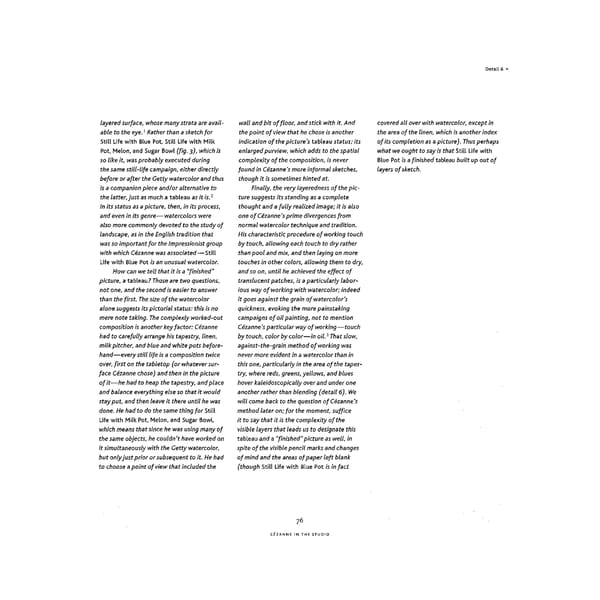Detail 6 > layered surface, whose many strata are avail- wall and bit of floor, and stick with it. And covered all over with watercolor, except in l able to the eye. Rather than a sketch for the point of view that he chose is another the area of the linen, which is another index Still Life with Blue Pot Still Life with Milk indication of the picture's tableau status; its of its completion as a picture). Thus perhaps Pot, Melon, and Sugar Bowl (fig. 3), which is enlarged purview, which adds to the spatial what we ought to say is that Still Life with so like it, was probably executed during complexity of the composition, is never Blue Pot is a finished tableau built up out of the same still-life campaign, either directly found in Cezanne's more informal sketches, layers of sketch. before or after the Getty watercolor and thus though it is sometimes hinted at. is a companion piece and/or alternative to Finally, the very layeredness of the pic- 2 the latter, just as much a tableau as it is. ture suggests its standing as a complete In its status as a picture, then, in its process, thought and a fully realized image; it is also and even in its genre—watercolors were one of Cezanne's prime divergences from also more commonly devoted to the study of normal watercolor technique and tradition. landscape, as in the English tradition that His characteristic procedure of working touch was so important for the Impressionist group by touch, allowing each touch to dry rather with which Cézanne was associated — Still than pool and mix, and then laying on more Life with Blue Pot is an unusual watercolor. touches in other colors, allowing them to dry, How can we tell that it is a "finished" and so on, until he achieved the effect of picture, a tableau? Those are two questions, translucent patches, is a particularly labor- not one, and the second is easier to answer ious way of working with watercolor; indeed than the first. The size of the watercolor it goes against the grain of watercolor's alone suggests its pictorial status: this is no quickness, evoking the more painstaking mere note taking. The complexly worked-out campaigns of oil painting, not to mention composition is another key factor: Cézanne Cezanne's particular way of working—touch had to carefully arrange his tapestry, linen, 3 by touch, color by color—in oil. That slow, milk pitcher, and blue and white pots before- against-the-grain method of working was hand—every still life is a composition twice never more evident in a watercolor than in over, first on the tabletop (or whatever sur- this one, particularly in the area of the tapes- face Cézanne chose) and then in the picture try, where reds, greens, yellows, and blues of it—he had to heap the tapestry, and place hover kaleidoscopically over and under one and balance everything else so that it would another rather than blending (detail 6). We stay put, and then leave it there until he was will come back to the question of Cezanne's done. He had to do the same thing for Still method later on; for the moment, suffice Life with Milk Pot, Melon, and Sugar Bowl, it to say that it is the complexity of the which means that since he was using many of visible layers that leads us to designate this the same objects, he couldn't have worked on tableau and a "finished"picture as well, in it simultaneously with the Getty watercolor, spite of the visible pencil marks and changes but only just prior or subsequent to it. He had of mind and the areas of paper left blank to choose a point of view that included the (though Still Life with Blue Pot is in fact 76 CÉZANNE IN THE STUDIO
 Cézanne in the Studio: Still Life in Watercolors Page 90 Page 92
Cézanne in the Studio: Still Life in Watercolors Page 90 Page 92